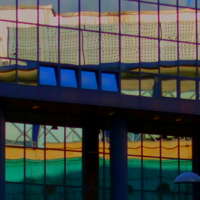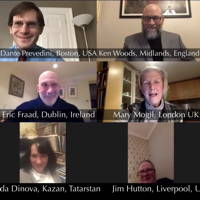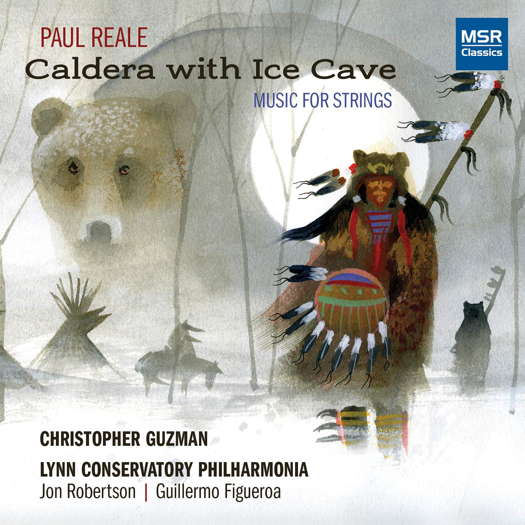- Morales
- Igor Kipnis
- Hong Kong
- Tactus Records
- Democratic People's Republic of Korea
- Dave Heath
- Bolshoi Theatre
- North Carolina
 CENTRAL ENGLAND: Mike Wheeler's concert reviews from Nottingham and Derbyshire feature high profile artists on the UK circuit - often quite early on their tours.
CENTRAL ENGLAND: Mike Wheeler's concert reviews from Nottingham and Derbyshire feature high profile artists on the UK circuit - often quite early on their tours.
 VIDEO PODCAST: Come and meet Eric Fraad of Heresy Records, Kenneth Woods, musical director of Colorado MahlerFest and the English Symphony Orchestra and others.
VIDEO PODCAST: Come and meet Eric Fraad of Heresy Records, Kenneth Woods, musical director of Colorado MahlerFest and the English Symphony Orchestra and others.

Very Satisfying
Music for strings by American composer Paul Reale,
enjoyed by GEOFF PEARCE
'Paul Reale shows himself as a fine composer for string ensemble ...'
Paul Reale is an American composer whose music I am rather fond of. His music is readily accessible, sometimes quirky and humorous, but in a style all of his own.
The first work on this disc, American Elegy (2008) is presented twice, first at the beginning of the disc and again at the end (where chimes are added). The composer calls it a 'kind of homage to Samuel Barber's Adagio for Strings'. The piece does not have the same deep sadness that the Barber work has, but there is a feeling of reverence that the composer was aiming for. It starts of with a pattern of repeated chords, and a broad tune soon comes in in the middle strings. The work is not hurried and is a kind of elegy.
Listen — Paul Reale: American Elegy
(track 1, 2:06-2:44) © 2019 Paul Reale :
Hextet (2017) is a three-movement work for strings, inspired by the Halloween and horror movies of the 1930s.
The first movement 'Tarantella' is a spirited dance with strong rhythms which the composer describes as a 'kind of demented dance with accompanying delirium'. Paul Reale shows himself as a fine composer for string ensemble and the movement (and indeed the whole work) is engaging.
Listen — Paul Reale: Tarantella (Hextet)
(track 2, 1:19-1:59) © 2019 Paul Reale :
The second movement, 'Zombies', is deliberately creepy, with a lot of atmospheric slides, rapid dynamic changes and clashing intervals. It is harmonically somewhat unsettled with modulations and melodies that emerge, only to be interrupted with strange rhythmic interjections or upward sweeps.
Listen — Paul Reale: Zombies (Hextet)
(track 3, 3:05-3:45) © 2019 Paul Reale :
The last movement, 'Walpurgisnacht', is a real Witches' Sabbath, with the devil on the fiddle. It is a fascinating movement, wild and abandoned. The writing is adventurous and effective, but still makes engaging listening.
Listen — Paul Reale: Walpurgisnacht (Hextet)
(track 4, 1:25-2:16) © 2019 Paul Reale :
The title work Caldera with Ice Cave, also known as Piano Concerto No 3, was originally conceived in 2002, and revised a number of times until this recorded version in 2012, scored for piano and string orchestra. It was inspired by a trip to a caldera and ice cave at the Bandera volcano in New Mexico, and draws musical inspiration from Berlioz's Harold in Italy and Don Quixote of Richard Strauss and is in two movements.
The first Movement, 'Fire', starts with piano and orchestra together in a kind of scale-like progression. The piano is generally part of the overall texture of the work, in spite of having a few prominent solos. The music is interesting and accessible, reminding me of composers such as Bloch. The piano is frequently used as an element of various chamber subgroups that emerge from time to time.
Listen — Paul Reale: Fire (Caldera with Ice Cave)
(track 5, 5:18-6:09) © 2019 Paul Reale :
The second movement 'Ice' starts quietly, for piano alone, and in places is somewhat static. The strings enter with a fairly eerie accompaniment which turns into a slow tune that the piano intertwines with. There are some surprising and rather beautiful resolutions to the tensions built up. One can feel the wonder as if walking through this ice cave. The scenes are always shifting and there are a number of changes from time to time, one of which is a lovely little ballad.
Listen — Paul Reale: Ice (Caldera with Ice Cave)
(track 6, 4:21-5:15) © 2019 Paul Reale :
Dancer's Dream is a kind of ballet without dancers, depicting a Viennese waltz. Unlike Ravel's La Valse, it uses deconstruction, fragmentation and 'polyrhythmic simultaneities'. This produces a masterful work for string ensemble. I like this piece very much. The Lynn Philharmonia is a fine ensemble.
Listen — Paul Reale: Dancer's Dream
(track 7, 4:51-5:43) © 2019 Paul Reale :
The Concerto Grosso (2015) draws inspiration from both Stravinsky and Bloch. The three movements use a different solo instrument: cello in first movement, viola in second and violin in the third. All three are used in the coda. As in the Bloch work of the same name, an obbligato piano is similarly employed.
The first movement 'Overture' opens in an emphatic and dramatic fashion. The texture is somewhat dense, but this thins out, as the music becomes slower and more lyrical, before it becomes dramatic again. This movement uses a clever juxtaposition of textures and orchestration as well as changes of mood.
Listen — Paul Reale: Overture (Concerto Grosso)
(track 8, 3:21-4:05) © 2019 Paul Reale :
The second movement, 'Lord of the Flies', inspired I presume by William Golding's book of the same name, is a strange and rather twisted piece, at times showing great tenderness, but there is an underlying disquiet. The various episodes in the music are punctuated by a rather sinister tremolo in the low strings. Towards the end, there is a build up of tension in the piano passage, but it subsides to a soft string ending.
Listen — Paul Reale: Lord of the Flies (Concerto Grosso)
(track 9, 4:44-5:23) © 2019 Paul Reale :
The last movement, 'Dies Irae', is somewhat savage at the beginning. The plainsong Dies Irae is played and gradually deconstructs over the course of the movement until only one note is left in the coda. There are dramatic moments and the texture and ideas are varied.
Listen — Paul Reale: Dies Irae (Concerto Grosso)
(track 10, 3:08-3:53) © 2019 Paul Reale :
The CD ends with a version of the first piece, American Elegy, in which chimes are added to the original string version. It gives an added, if slightly sinister edge to the work. The composer added them to give a feeling of greater gravity. I am reminded of the mournful tolling of church bells at a funeral.
This is a disc I quite like as I am partial to Paul Reale's compositions, and I'm also impressed by the other discs of his works I have reviewed. The forces used produce a very fine result in all aspects, not only the solo performances but also the orchestral string playing. The conductors here - Guillermo Figueroa and Jon Robertson - help to produce a very satisfying result.
Copyright © 26 May 2020
Geoff Pearce,
Sydney, Australia

CD INFORMATION - PAUL REALE: CALDERA WITH ICE CAVE
FURTHER INFORMATION - PAUL REALE
FURTHER INFORMATION - MSR CLASSICS


